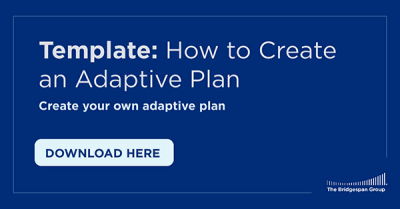Since 2020, there’s been a good deal written (including by Bridgespan) about the power of resilience—both personal and institutional. As we’ve worked and learned alongside nonprofits in recent years, we’ve been reminded that resilience—the capacity to not only navigate difficult challenges or traumatic events, but also improve along the way—can be imperative to sustaining an organization’s health.
A key piece of an organization’s resilience resides in its strategy—and whether it can respond to current events, crises, threats, and opportunities. We call a strategy that can do this an adaptive strategy: one in which nonprofit leaders can make progress toward their long-term goals while staying flexible in the shorter term.
Making an Adaptive Strategic Plan
When creating an adaptive strategic plan, leaders balance the long and short view. They recognize that a vision of the organization’s long-term destination is essential, acting as a north star to guide the team’s decision making over time.
They pair that view with a few critical strategic priorities that the organization can pursue over the next 12 to 24 months.
Adaptive planning is also characterized by a willingness to consider what might go wrong. Adaptive planners explicitly aim to identify risks and opportunities, so they are prepared to pivot quickly as circumstances require.
In the end, creating an adaptive plan enables your nonprofit organization to align on:
- A clear long-term vision: Your organization agrees on where you’re headed.
- Near-term destination and priorities: Your team understands what is most important to achieve in the near term.
- Plans for the unexpected: You accept uncertainty and lean into planning for risks and identifying potential opportunities. This means always having a contingency plan—a Plan B—in case your original plan goes sideways.

1. A clear long-term vision
Any nonprofit organization can become stronger and more resilient in the face of the unexpected by sharpening its adaptive planning skills. It may sound counterintuitive, but the first step in adaptive planning is to define where the organization would like to be 10 or more years down the road. “Clarifying that long-term destination can serve as an anchor in the planning process,” says Lindsey Waldron, manager in Bridgespan’s Boston office. “The more you have clarity on where you are headed, the less likely it is for short-term shocks to throw you off course
When MacDowell, the nation’s first artist residency program, began an adaptive planning process amid the pandemic in 2020, it was a challenge to imagine how the organization might shift from what it was to what it might be.
Facilitators during a planning session used an affirmative framing technique and asked the group to imagine that after 10 years MacDowell was wildly successful. What would the world look like if MacDowell no longer needed to exist?
Once a few people chimed in, “…there was this lighting up across the rest of the group,” MacDowell director of internal communications and human engagement Jenni Wu recalled. “We all got really excited about this vision.”
2. Near-term destination and priorities
Once adaptive planning teams agree upon a long-term vision, they can then turn their attention to what needs to happen in the next two to three years to get on the right track and start making progress toward that goal. In this planning phase, Waldron encourages organizations to set ambitious goals, then subsequently pressure-test bold ideas for feasibility. Typically, this involves choosing the three to five focal priorities toward which the organization can devote disproportionate time and resources.
These priorities can be divided into two categories:
- Programmatic priorities involve figuring out which programs or services to grow, evolve, establish, or exit.
- Organizational and financial priorities include determining what people and capabilities the organization needs and how it can remain (or become) financially sustainable while pursuing a strong and inclusive culture.
- Expansion of services: FLY will be deeply present in its current three counties through direct service and systems change work that responds to community needs. We will also expand our services to two more counties.
- Evidence building: FLY will develop the organizational muscle needed to adopt a rapid-cycle testing approach to evidence-building, continuous quality improvement, and strategic growth initiatives
3. Plans for the unexpected
Adaptive planning means hoping for the best, but anticipating challenges and preparing in case things don’t go as expected. Planning for potential downside scenarios allows organizations to act boldly in the present moment.
The adaptive planning process asks leaders to evaluate and plan for two types of risks: those rooted in uncertainty and those that involve knowledge gaps.
- Risks rooted in external uncertainty: Organizations must make plans even though many factors lie outside of their control. Will that contract get renewed by a funder? When will the school district allow for the return to in-person programming?
- Risks that involve knowledge gaps: Particularly when launching new activities, organizations may not yet know the best way to achieve impact, or which people and skills they need to reach their goals. However, those are questions that can sometimes be answered through research and piloting.
To know whether to activate a back-up plan, leaders will want to monitor early signals to understand whether plans are on track or off. It’s valuable to consider in advance what signals will indicate success or trigger a shift to a Plan B. Discussing these questions ahead of time can help leaders both monitor progress and confidently make a shift.
Adaptive planning takes investment and collaboration to build both short-term and long-term visions. It also takes regular monitoring of progress against priorities, so the team can pivot when needed. If it sounds like work, well, it is. But it’s also a muscle that builds with practice and allows an organization to make progress even in the face of inevitable uncertainties.
Naomi McSwain, former executive director of the Al Wooten Jr. Youth Center, a neighborhood youth center in South Los Angeles, emphasizes the importance of involving the board of directors and keeping them in the loop throughout the adaptive planning process. McSwain presented a draft version of their adaptive plan at a board retreat, where she says board members provided great feedback, but did not request any changes.
“Bridgespan’s adaptive planning process challenged us to have bold thinking,” says McSwain. “We proposed some solutions that we had not articulated before because of cost concerns, and the board turned out to be very supportive of these ideas. In fact, when I mentioned that we needed an accounting assistant, one of the board members called me up after the meeting and offered to pay for that position."
Monica Anzaldi then New Jersey executive director at America Needs You (now chief of staff at The Nature Conservancy, New York) says to gain firm support, it’s vital to have board members who are not afraid of change. “I feel the nature of being a nonprofit is recognizing that you have to change or die,” she says. “That doesn’t mean changing your mission, but it does mean changing and growing in ways that stay true to your mission. For us, the job landscape has changed so much that the professional development curriculum we were delivering 10 years ago would be irrelevant today. As the landscape changes, nonprofits need to change too to stay relevant."
Both America Needs You and Al Wooten Jr. Youth Center recently participated in Bridgespan’s Creating an Adaptive Plan Accelerator program. If your organization is interested in engaging in adaptive planning and would like some guidance and support, visit our website to learn more – sessions start in February and September of each year.
Download the Template
Fill in the form below to download a copy of the "How to Create an Adaptive Plan" template. We use this information to improve our work and determine which audiences we are reaching. We will never sell or share the information you provide without your explicit permission. If you would rather download the template without using the form, you can download it directly.


